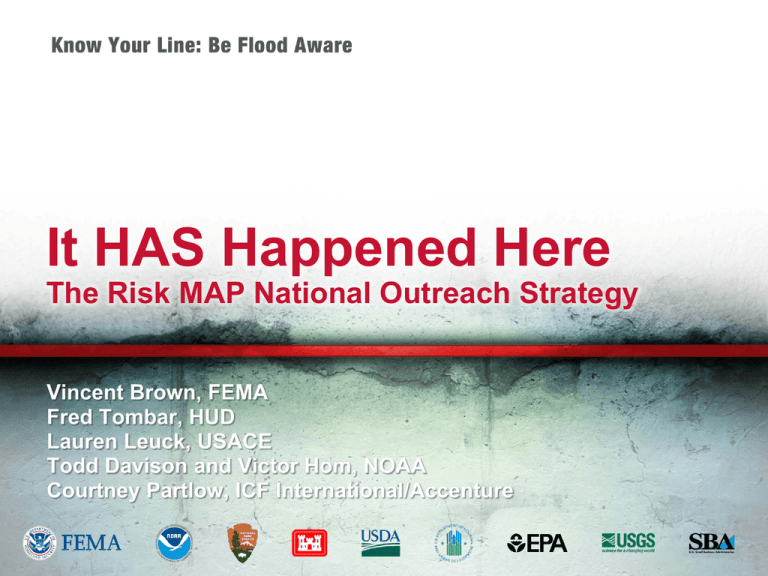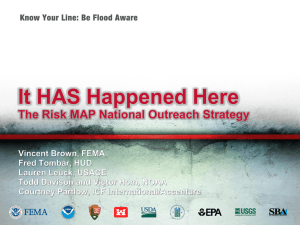It HAS Happened Here The Risk MAP National Outreach Strategy
advertisement

It HAS Happened Here The Risk MAP National Outreach Strategy The Problem Floods are the most common and costly natural disaster in the United States and all communities are vulnerable Over a 30-year mortgage, homes and businesses in high-risk areas have a 26% or greater chance of flooding • 2 ½ times greater than the chance of fire People and businesses often take few steps to protect themselves from floods “It won’t happen here.” 2 Part of the Solution FEMA knows that the public does not want to hear about flooding from the Federal government* • Prefer to hear about it from local officials Developed a strategy for a high water mark campaign that relies on local ownership and implementation • Showcasing the outcome of a community’s most severe flood can offer a powerful testimony and daily reminder to local citizens FEMA approached other Federal agencies with similar concerns about flooding to jointly implement the strategy The High Water Mark Initiative, “Know Your Line: Be Flood Aware” was born • Nine Federal agencies working together • Goal is to motivate individuals to reduce risk *Per findings of 2010 and 2011 Risk MAP Flood Awareness Surveys 3 Participating Agencies 4 “Know Your Line” Overview Description • Encourages communities to post markers on prominent buildings to identify how high flood waters have risen in the past, conduct a kick-off event, then reinforce with outreach over time Objectives • Raise flood risk awareness, drive action to reduce risk Audience • Homeowners and renters, youth, elderly, local businesses Features • Turnkey outreach strategy and customizable tools and materials to allow communities to quickly establish a tailored initiative • Established partnerships with numerous agencies and organizations to support widespread outreach 5 Benefits of Community Participation Underscores its commitment to the well-being of its citizens and local business community Galvanizes the community to take steps now to reduce the often devastating impact of floods Earn Community Rating System Rating (CRS) points to reduce the cost of flood insurance across the community Put Federal and state mitigation assistance funds to work 6 First Step: Pilot Communities Identified 6 potential pilot communities • Talking with them now to determine their interest in participating To choose pilots, we considered: • Regional and demographic diversification • Subject to a range of types of flooding • Different flooding histories • Availability of data • Availability of funding • Strong relationships with community members or demonstrated interest in this type of activity • Highly visible locations 7 Pilot Project Responsibilities Federal agency point of contact will: • Help the community tailor the strategy and materials to suit their needs • Provide recommendations and consultation on implementation activities • Provide recognition to pilot participants online and at conference and trade association meetings • Help the community determine where the signs will go Pilot participants will: • Establish a point-of-contact for “Know Your Line” activities • Tailor the strategy and materials to suit their specific needs • Launch the initiative and sustaining activities • Provide feedback, best practices, and insights to help us improve the campaign prior to national roll-out • Potentially act as a mentor to communities moving forward 8 Next Step: National Roll-Out The High Water Mark Working group will update, enhance, and add tools based on pilot feedback We will then open participation up nationwide, hopefully in time for National Preparedness Month in September Announcements will be made to local officials through many vehicles, potentially including: • Outreach through CRS Program • Articles in trade association newsletters (e.g., NACo, U.S. Conference of Mayors) • Outreach through Federal agency contacts located throughout the country 9 Tools for Communities* Customizable “Know Your Line” sign and printing instructions Access to data to determine where signs should be placed Launch event ideas Customizable community outreach plan Pre-existing relationships with supporting organizations that can be engaged at the local level Website to house local flood information and “Know Your Line” events • In development Press materials to support launch • Release • Advisory Campaign “help desk” for feedback or assistance *More to come based on pilot community feedback 10 Timeline 11 For More Information Please contact Vince Brown at vincent.brown@fema.dhs.gov or 202.646.2725 12 Q&A Questions? 13







